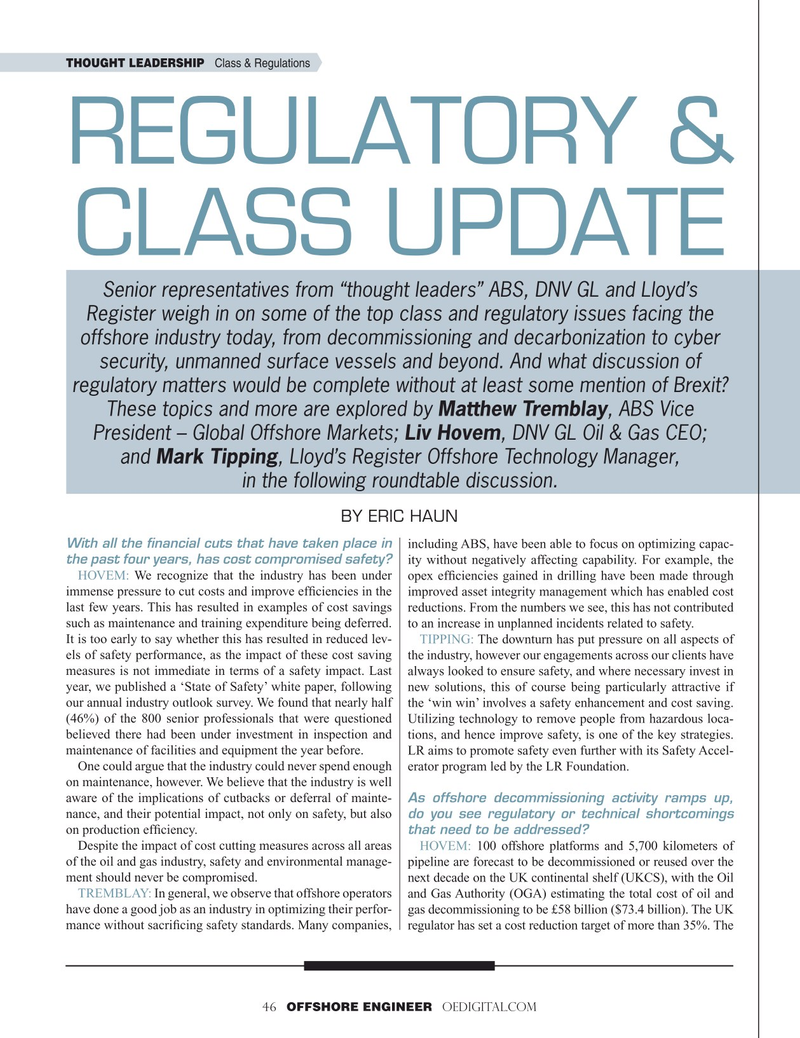
Page 46: of Offshore Engineer Magazine (May/Jun 2019)
Offshore Renewables Review
Read this page in Pdf, Flash or Html5 edition of May/Jun 2019 Offshore Engineer Magazine
THOUGHT LEADERSHIP Class & Regulations
REGULATORY &
CLASS UPDATE
Senior representatives from “thought leaders” ABS, DNV GL and Lloyd’s
Register weigh in on some of the top class and regulatory issues facing the offshore industry today, from decommissioning and decarbonization to cyber security, unmanned surface vessels and beyond. And what discussion of regulatory matters would be complete without at least some mention of Brexit?
These topics and more are explored by Matthew Tremblay, ABS Vice
President – Global Offshore Markets; Liv Hovem, DNV GL Oil & Gas CEO; and Mark Tipping, Lloyd’s Register Offshore Technology Manager, in the following roundtable discussion.
BY ERIC HAUN
With all the financial cuts that have taken place in including ABS, have been able to focus on optimizing capac- the past four years, has cost compromised safety? ity without negatively affecting capability. For example, the
HOVEM: We recognize that the industry has been under opex ef? ciencies gained in drilling have been made through immense pressure to cut costs and improve ef? ciencies in the improved asset integrity management which has enabled cost last few years. This has resulted in examples of cost savings reductions. From the numbers we see, this has not contributed such as maintenance and training expenditure being deferred. to an increase in unplanned incidents related to safety.
It is too early to say whether this has resulted in reduced lev- TIPPING: The downturn has put pressure on all aspects of els of safety performance, as the impact of these cost saving the industry, however our engagements across our clients have measures is not immediate in terms of a safety impact. Last always looked to ensure safety, and where necessary invest in year, we published a ‘State of Safety’ white paper, following new solutions, this of course being particularly attractive if our annual industry outlook survey. We found that nearly half the ‘win win’ involves a safety enhancement and cost saving. (46%) of the 800 senior professionals that were questioned Utilizing technology to remove people from hazardous loca- believed there had been under investment in inspection and tions, and hence improve safety, is one of the key strategies. maintenance of facilities and equipment the year before. LR aims to promote safety even further with its Safety Accel-
One could argue that the industry could never spend enough erator program led by the LR Foundation.
on maintenance, however. We believe that the industry is well aware of the implications of cutbacks or deferral of mainte- As offshore decommissioning activity ramps up, nance, and their potential impact, not only on safety, but also do you see regulatory or technical shortcomings on production ef? ciency. that need to be addressed?
Despite the impact of cost cutting measures across all areas HOVEM: 100 offshore platforms and 5,700 kilometers of of the oil and gas industry, safety and environmental manage- pipeline are forecast to be decommissioned or reused over the ment should never be compromised. next decade on the UK continental shelf (UKCS), with the Oil
TREMBLAY: In general, we observe that offshore operators and Gas Authority (OGA) estimating the total cost of oil and have done a good job as an industry in optimizing their perfor- gas decommissioning to be £58 billion ($73.4 billion). The UK mance without sacri? cing safety standards. Many companies, regulator has set a cost reduction target of more than 35%. The 46 OFFSHORE ENGINEER OEDIGITAL.COM

 45
45

 47
47